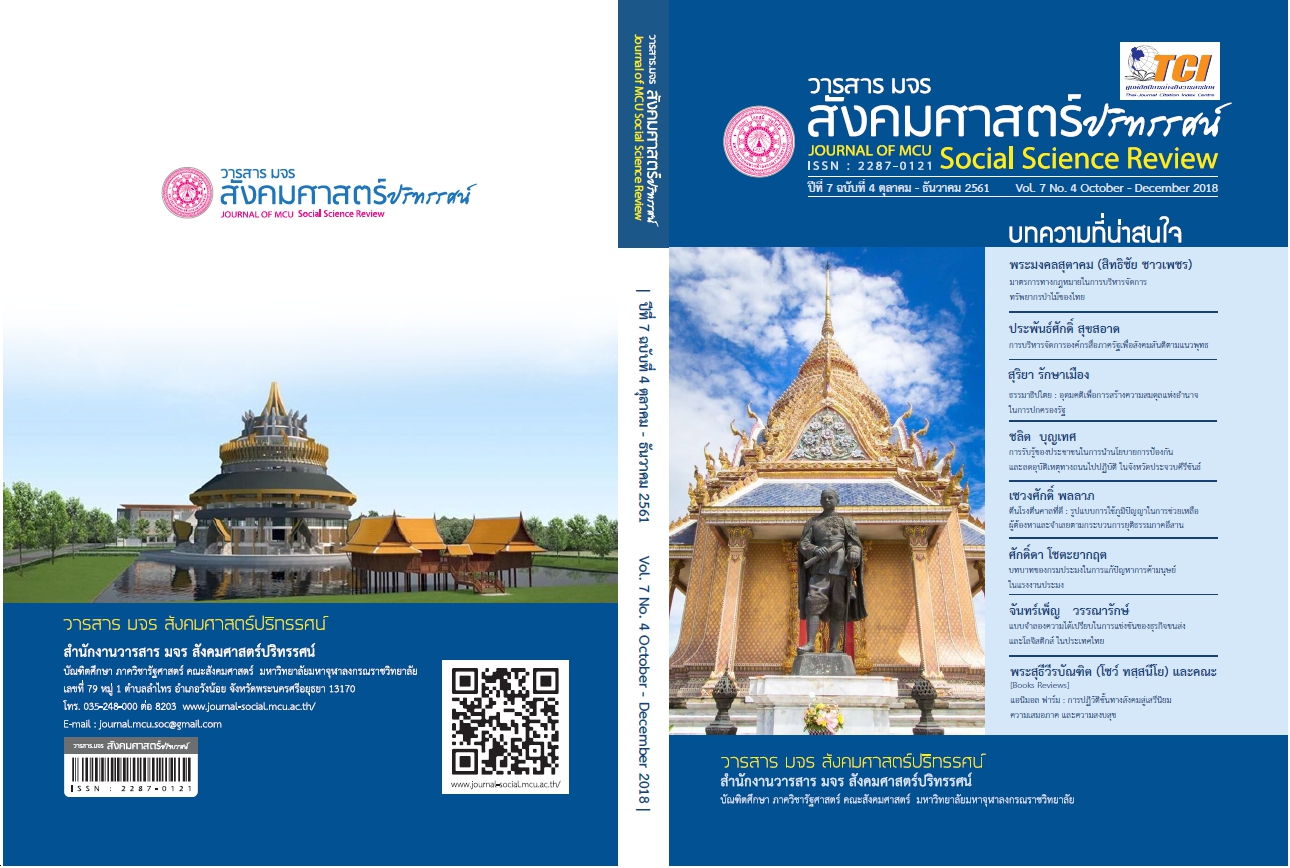แบบจำลองความได้เปรียบในการแข่งขันของธุรกิจขนส่งและโลจิสติกส์ ในประเทศไทย
คำสำคัญ:
แบบจำลองความได้เปรียบในการแข่งขัน, ธุรกิจขนส่งและโลจิสติกส์ ADVL model.บทคัดย่อ
บทความนี้มีวัตถุประสงค์ (1) เพื่อศึกษาปัจจัยเหตุของความได้เปรียบในการแข่งขัน และผลการดำเนินงานทางธุรกิจ (2) เพื่อศึกษาอิทธิพลของปัจจัยเหตุความได้เปรียบในการแข่งขันที่มีต่อผลการดำเนินงานทางธุรกิจ (3) เพื่อสร้างแบบจำลองความได้เปรียบในการแข่งขัน ของธุรกิจขนส่งและโลจิสติกส์ ในประเทศไทย กลุ่มตัวอย่าง คือ ผู้ประกอบการที่เป็นสมาชิกกับสมาคมขนส่งโลจิสติกส์ไทย จำนวน 220 แห่ง ได้มาโดยวิธีการสุ่มตัวอย่างแบบหลายขั้นตอน (Multi-Stage-Sampling) ผู้ให้ข้อมูล คือ ผู้ประกอบการแห่งละ 2 คน รวมผู้ให้ข้อมูล จำนวน 440 คน เก็บรวบรวมข้อมูลโดยการใช้แบบสอบถามระหว่างเดือนสิงหาคม 2560 และได้รับแบบสอบถามกลับคืนจานวน 396 ฉบับ คิดเป็นอัตราการตอบกลับคืน (Response Rate) ร้อยละ 90 วิเคราะห์ข้อมูลโดยใช้เทคนิคการวิเคราะห์โมเดลสมการโครงสร้าง (Structural Equation Modeling: SEM) ผลการวิจัย พบว่า (1) ปัจจัยเหตุ ประกอบด้วย ระบบการทำงาน ทุนมนุษย์ เครือข่ายทางธุรกิจ ความสามารถทางเทคโนโลยี และองค์กรแห่งนวัตกรรม (2) ปัจจัยเหตุ ทั้ง 5 มีอิทธิพลทางตรงเชิงบวกต่อความได้เปรียบในการแข่งขัน และมีอิทธิพลทางอ้อมต่อผลการดำเนินงานทางธุรกิจ และ (3) แบบจำลอง ADVL Model สอดคล้องกับข้อมูลเชิงประจักษ์ โดยพิจารณาจากค่าดัชนีความกลมกลืนทั้ง 6 ดัชนีที่ผ่านเกณฑ์การยอมรับ คือค่าดัชนี c2/df = 0.94, CFI = 1.00, GFI = 0.98, AGFI = 0.95, RMSEA = 0.000 และ SRMR = 0.0098 และแบบจำลอง ADVL Model ประกอบด้วย 7องค์ประกอบหลัก และ 19 องค์ประกอบย่อย ดังนี้ (1) ระบบการทำงาน มี 4 องค์ประกอบ (2) ทุนมนุษย์ มี 3 องค์ประกอบ (3) เครือข่ายทางธุรกิจ มี 3 องค์ประกอบ (4) ความสามารถทางเทคโนโลยี มี 3 องค์ประกอบ (5) องค์กรแห่งนวัตกรรม มี 2 องค์ประกอบ (6) ความได้เปรียบในการแข่งขัน มี 2 องค์ประกอบ และ (7) ผลการดำเนินงานทางธุรกิจ มี 2 องค์ประกอบ
เอกสารอ้างอิง
Alter & Sarkar. (2011).Metamodel for Service Analysis and Design Based on an Operational View of Service and Service Systems. Service Science, 4(3), 218-235.
Arun R. (2015). Fit and Misfit of Plural Sourcing Strategies and IT-Enabled Process Integration
Benghozi and Chamaret (2010) The Future of Resource-Based Theory Revitalization Or Decline?. Journal of Management, 37(5), 1299-1315.
Degerstedt, L. (2015). Social Competitive Intelligence-Socio-Technical Themes and Values for The Networking Organization. Journal of Intelligence Studies in Business, 5(3).
Gittell, J. H., Seidner, R., & Wimbush, J. (2010). A Relational Model of How High-Performance Work Systems Work. Organization Science, 21(2), 490-506.
Jonathan, O. A., Seun, A. A., & James, O. O. (2016). Managerial Capability and The Innovative Prowess Of Entrepreneurial Firms In Nigeria.World Journal of Research And Review (WJRR) Volume-2, Issue-3, March 2016 Pages 18-21.
Kirati Yodyingyong. (2009). Innovation Oraganization : Concept and Process.Bangkok,Chulalongkorn University.
ดาวน์โหลด
เผยแพร่แล้ว
รูปแบบการอ้างอิง
ฉบับ
ประเภทบทความ
สัญญาอนุญาต
ลิขสิทธิ์ (c) 2019 วารสาร มจร สังคมศาสตร์ปริทรรศน์

อนุญาตภายใต้เงื่อนไข Creative Commons Attribution-NonCommercial-NoDerivatives 4.0 International License.
เพื่อให้เป็นไปตามกฎหมายลิขสิทธิ์ ผู้นิพนธ์ทุกท่านต้องลงลายมือชื่อในแบบฟอร์มใบมอบลิขสิทธิ์บทความให้แก่วารสารฯ พร้อมกับบทความต้นฉบับที่ได้แก้ไขครั้งสุดท้าย นอกจากนี้ ผู้นิพนธ์ทุกท่านต้องยืนยันว่าบทความต้นฉบับที่ส่งมาตีพิมพ์นั้น ได้ส่งมาตีพิมพ์เฉพาะในวารสาร มจร สังคมศาสตร์ปริทรรศน์ เพียงแห่งเดียวเท่านั้น หากมีการใช้ภาพหรือตารางหรือเนื้อหาอื่นๆ ของผู้นิพนธ์อื่นที่ปรากฏในสิ่งตีพิมพ์อื่นมาแล้ว ผู้นิพนธ์ต้องขออนุญาตเจ้าของลิขสิทธิ์ก่อน พร้อมทั้งแสดงหนังสือที่ได้รับการยินยอมต่อบรรณาธิการ ก่อนที่บทความจะได้รับการตีพิมพ์ หากไม่เป็นไปตามข้อกำหนดเบื้องต้น ทางวารสารจะถอดบทความของท่านออกโดยไม่มีข้อยกเว้นใดๆ ทั้งสิ้น





